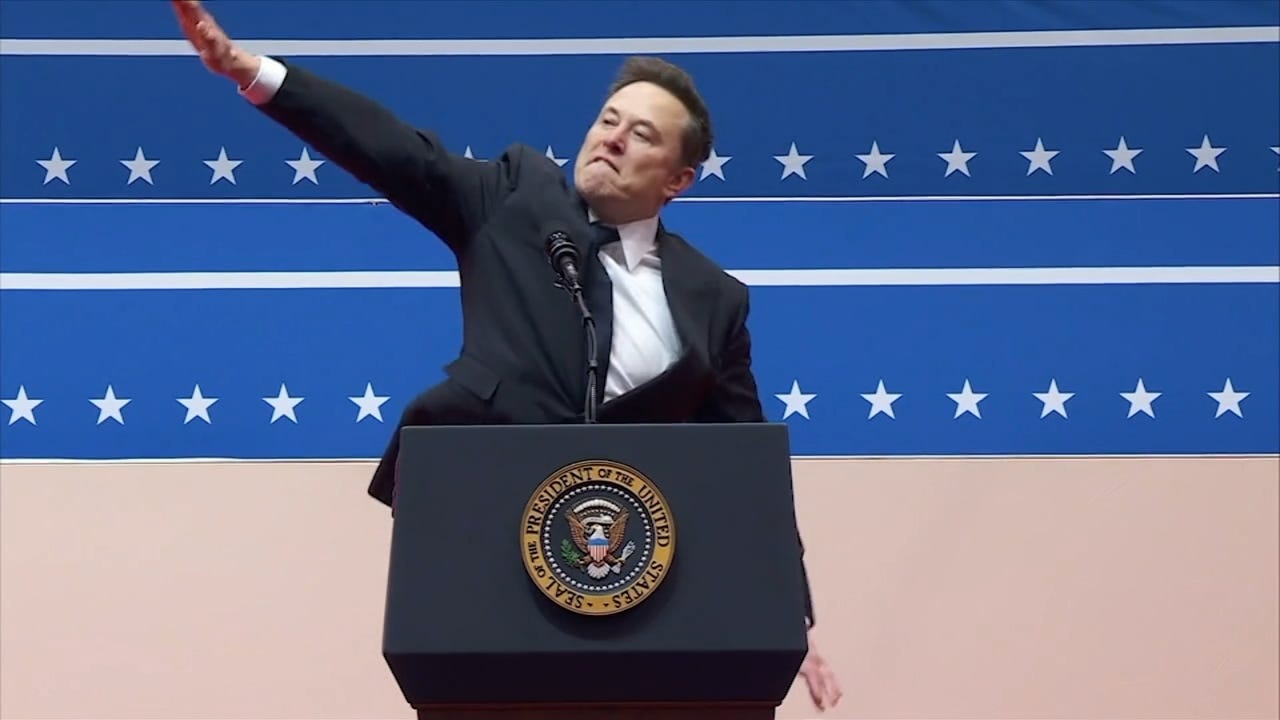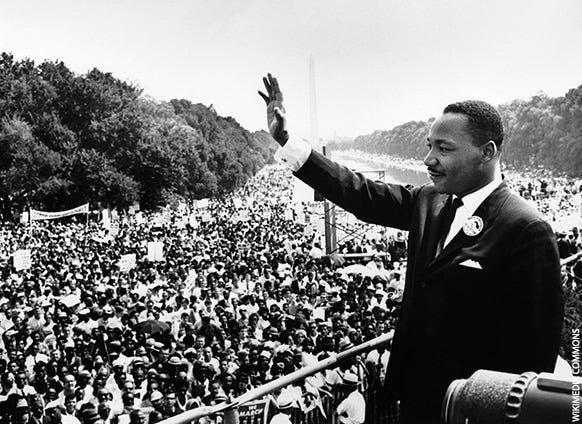RE: Your subscription to the matrix
🌀 What Quantum physics, Elon Musk, & Dr. King Jr.'s dream have in common
Listen to a version of this column on the “Poetry in Eden” podcast, episode #28, available on Spotify or Apple podcasts. That version also attached here for easy listening.
With rising readership and open rates, please continue engaging here with direct likes and comments. This helps me more than you know.
Purpose, Found by “Poetry in Eden” is not a column about the latest trending pop songs (“❤️ Debí tirar más fotos de cuando te tuve. Debí darte más beso' y abrazo' las vece' que pude”) or delightful restaurants (🤪 I really want to try Borgo and Chez Fifi in NYC soon).
“Poetry in Eden” has a mission to share what I have uncovered about the universal human search for meaning and purpose through philosophy and poetry, while raising awareness about healing generational trauma through historical, geopolitical, and psychological research.
If the mission resonates with you and you are open-minded to research transformed into bite-size content, you have come to the right place, my friend!

Welcome to your annual subscription to the matrix! Would you like to renew it at a discounted rate?
➡ The Future Predicts the Past ⬅
The other day, we were listening to an audiobook recommended by a good friend. One of the chapters focused entirely on quantum physics and its foundational theories, including a detailed explanation of retrocausality.
I had never heard of retrocausality before and the chapter was incredibly dense. I began to take notes.
Retrocausality challenges the traditional concept of cause and effect. According to this theory, an effect can occur before the cause—and, in certain cases, it does. It is as if you feel pain before an injury happens or hear the sound of glass breaking before it hits the floor.
The foundation of retrocausality lies in time symmetry. Time symmetry suggests that today is indistinguishable from tomorrow, just as it is from the past. The laws of physics governing today, tomorrow, and the past remain consistent. If time symmetry holds true, then retrocausality becomes a reality—the future can predict the past.
🎙 NEW: Listen to the “Poetry in Eden” podcast on Spotify or Apple podcasts. Episode #28 is a version of this week’s column.
Alright, alright—I was a bit suspicious and scratching my head too. You may ask, how can the future predict the past? Well, our choices today are shaping the future into what it becomes.
For example, if our future selves are happy, healed, and authentic, then it means the choices we are making today—our current selves—are aligning with those ideals. The more we heal in the present, the more healed our future selves will be, and by extension, the more healed the world will become. 🤯
I am still just getting into these quantum theories, but it is interesting. My focus on healing generational trauma combined with these theories confirm that healing creates a ripple effect—not just for us but for the entire planet.
So, how about some more examples on retrocausality? In fact, the basis of many religions is rooted in retrocausality. If you believe in any form of reincarnation, you inherently believe in retrocausality. For example, if someone dies to live again, and their future self is predetermined by choices made today, then the future is, in a sense, predicting the past.
Consider nature and trees as another example. A seed is planted and grows into a mighty oak tree. That oak tree, perhaps after hundreds of years, eventually dies but leaves behind countless acorns, each capable of producing more strong trees. The future tree looks back to the past—or what is now the present—acknowledging its origin: another resilient tree. What truly separates the future tree from the past tree, other than the passage of time (and DNA variations)?
And, what is time? Let’s dive into that topic another time. . .😅
⌛ So, History is a Great Indicator for the Future?⌛
Elon Musk is a huge believer in the quantum realm. He insists:
“There’s a one in billions chance we’re in base reality ”. . .(i.e. we are living in a simulation). source
Maybe you saw it, maybe you did not, but I cannot excuse Elon Musk for giving the Nazi salute, twice, during the January 20th inauguration, following his strange speech about ‘this is what victory feels like.’

If Musk believes in quantum reality, he understands the power of re-introducing a symbol like this which historically had a viral influence on culture and society (i.e. the real definition of a meme). Given the resurgence of Neo-Nazi activity in Germany leading up to their February election, coupled with Musk's recent attendance at their rally, there should be growing concern about where this is all going.
Yes, Musk is an intelligent man and, for me, blunders like these cannot be excused. All the excuses I have been reading about remind me of a quote from Ray Bradbury’s book, Fahrenheit 451:
“There was a silly damn bird called a phoenix back before Christ, every few hundred years he built a pyre and burnt himself up. He must have been the first cousin to Man. But every time he burnt himself up he sprang out of the ashes, he got himself born all over again. And it looks like we're doing the same thing, over and over, but we've got one damn thing the phoenix never had. We know the damn silly thing we just did. We know all the damn silly things we've done for a thousand years and as long as we know that and always have it around where we can see it, someday we'll stop making the goddamn funeral pyres and jumping in the middle of them. We pick up a few more people that remember every generation.”
Are we watching the world burn? Are we ignoring our collective history and memory? If the future truly predicts the past, then something we are heading toward has already influenced society—making it malleable, unquestioning, and power-hungry enough to overlook greed, hatred, and genocide. If we are still witnessing the repetition of history, it is clear that this issue has not been resolved. Instead, it has grown, evolved, and resurfaced over the past 80 years (i.e. since the end of WWII as we see the Nazi salute reemerge).
That also means, in America, since Trump is back, the American issues have not been resolved, and instead have grown, evolved, and resurfaced over the past 4 years. This present-future self is either 1. here to resolve things or 2. here to add fuel to an ever-growing self-interested pyre.
💭 How Can We Access a Timeline Where Dr. King Jr.’s Dream is a Reality? 💭
Let’s say we want the future to be something like what Dr. Martin Luther King Jr. dreamed of.
🎙NEW: Happy birthday and rest in power, Dr. Martin Luther King Jr!
Listen to podcast episode #8, ‘Do You Have a Dream Too?’ where I dissect one of his most famous speeches.
What did Dr. King Jr. dream of? He dreamed of:
A place where it is self-evident that all men are created equal.
A place where people are not be judged by the color of their skin (or sex/gender I might add) but by the content of their character.
A place where we do not seek to satisfy our thirst for freedom by drinking from the cup of bitterness and hatred.
It seems many of our present selves have not caught up to this future dream. When some of the richest people in the world make decisions on behalf of everyone, benefiting only a select few, it might suggest that our future selves have failed to adjust for the better.
The high-vibration future Dr. King Jr. was walking towards still seems just out of reach . . .or more optimistically, maybe somehow we will resolve what our history could never resolve before, providing a way for all Americans to live with dignity, inspiring and propelling the rest of the world into a quantum leap towards universal positive change.
Yeah! Maybe that’s it—and maybe that future will continue to predict the choices we make today.
🎉 POEM OF THE WEEK 🎉
THIS LIFE HAS JUST BEGUN
The sun shone today, so bright and unexpected.
Yes, I’ve been here before on a different timeline.
It’s like a heavy force propelled me to choice.
For some, a window is the entire sky.
The music blared over the broken sound system.
I plugged my nose as I was plunged underwater—
And there in the bright depths with the mirror cave
Laid the grave of all the forgotten masquerades.
It was an honour fit for the gods,
But maybe I forgot drifting in the undercurrent
That I too am god and my truth shines through
Luminescent, iridescent, and cobalt blue.
Twinkle, twinkle, giant galaxy—
Thank you for winking back at me.
"Yes, go live and become," said that bright gaseous sun,
With its rays cutting through the water. "This life has just begun!"






thank you for introducing the concept of retrocausality to me.
This column is a rare convergence of poetic philosophy, quantum theory, and geopolitical awareness, seamlessly integrating high-concept physics like retrocausality and time symmetry with trauma theory, sociohistorical critique, and spiritual inquiry. Its strength lies in its intellectual ambition: transforming academic and speculative domains into a compelling, accessible meditation on the intersection of individual healing and collective fate.
The invocation of retrocausality as a metaphor for personal agency and historical reckoning is particularly potent. By framing healing as a backward- and forward-moving phenomenon (where present decisions echo into both past and future) you bridged physics with psychology, offering a radical reframing of time as non-linear, co-creative, and ethically consequential. This is reinforced by references to reincarnation and the intergenerational transmission of trauma, which draw from both mystical traditions and systems theory.
Further, the section connecting symbolic resurgence (like the Nazi salute) with cultural memetics and quantum manipulation of perception (a simulation hypothesis) is not only provocative but analytically precise. It challenges readers to question the ethics of cultural repetition, the predictive power of memory, and the vulnerability of collective consciousness to charismatic influence, especially within digital ecosystems.
The rhetorical juxtaposition of Dr. King Jr.’s dream with the simulation hypothesis and entropy of current sociopolitical patterns raises urgent philosophical questions: If the future can influence the past, then which future are we aligning with? This speculative moral calculus is the column’s most significant contribution, suggesting that history is not static but entangled with emergent possibilities shaped by the healing (or harm) enacted in the present.
Even the closing poem, while lyrical, operates as a fractal reflection of the column’s thesis: identity as fluid, divinity as self-remembered, and time as nonlinear propulsion. It’s a call to action wrapped in dream logic, a reminder that personal choice reverberates across timelines.
In sum, this piece is not merely thoughtful, it is intellectually rigorous, multidisciplinary, and brave in its effort to trace the hidden architecture linking trauma, time, and the future of consciousness itself.